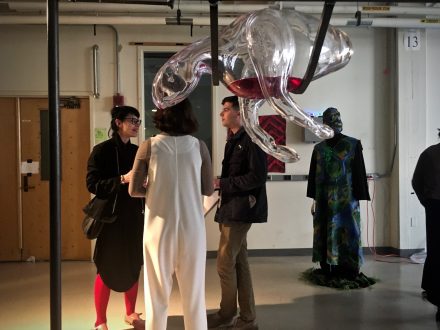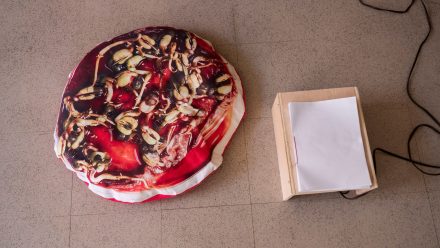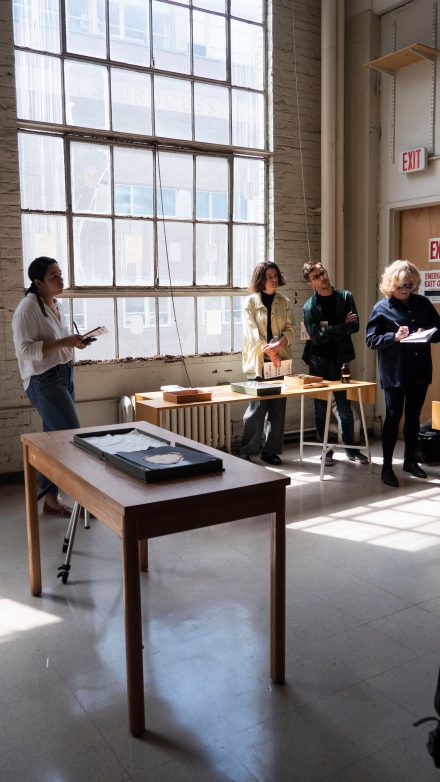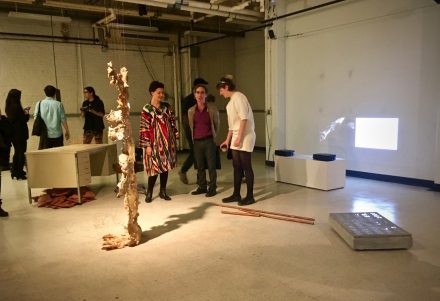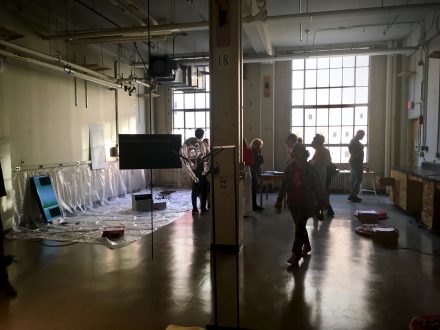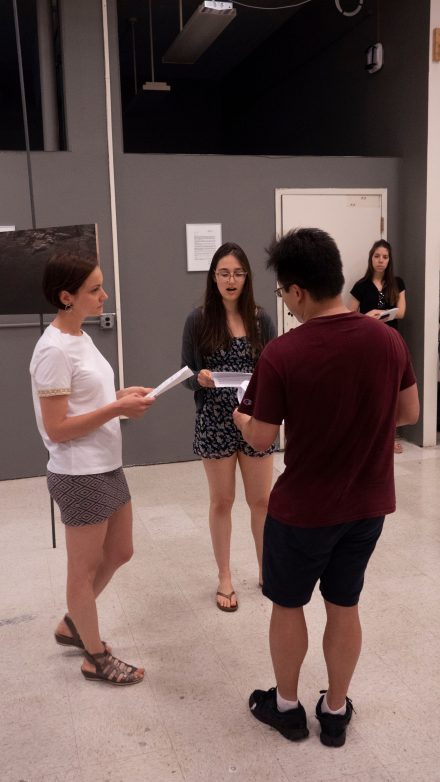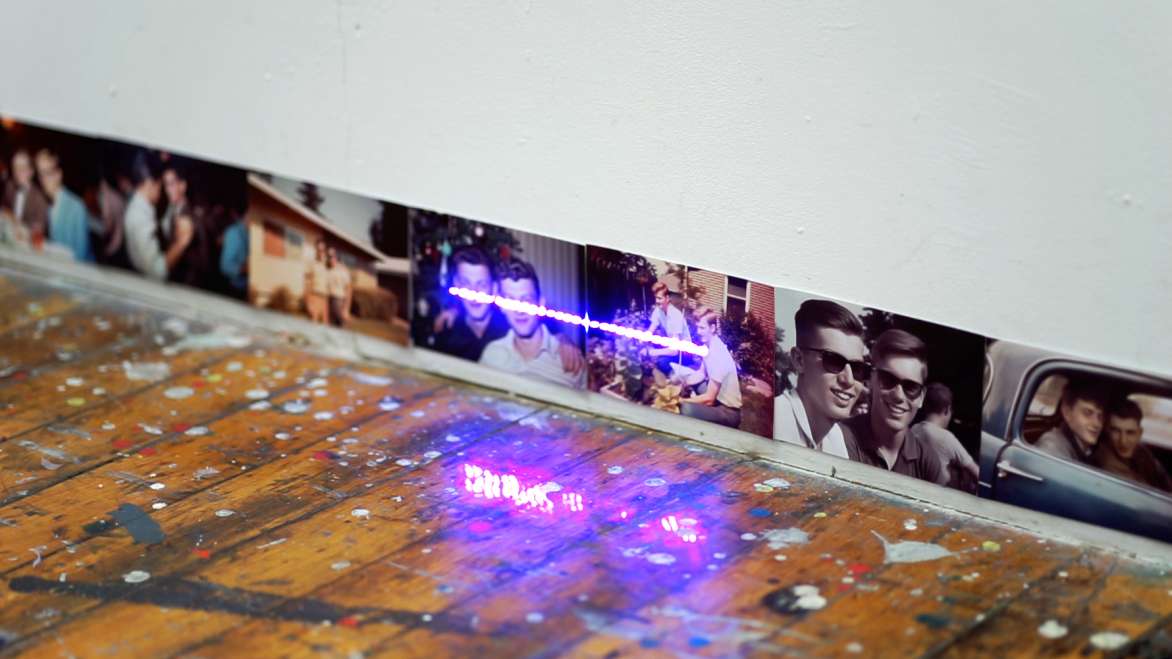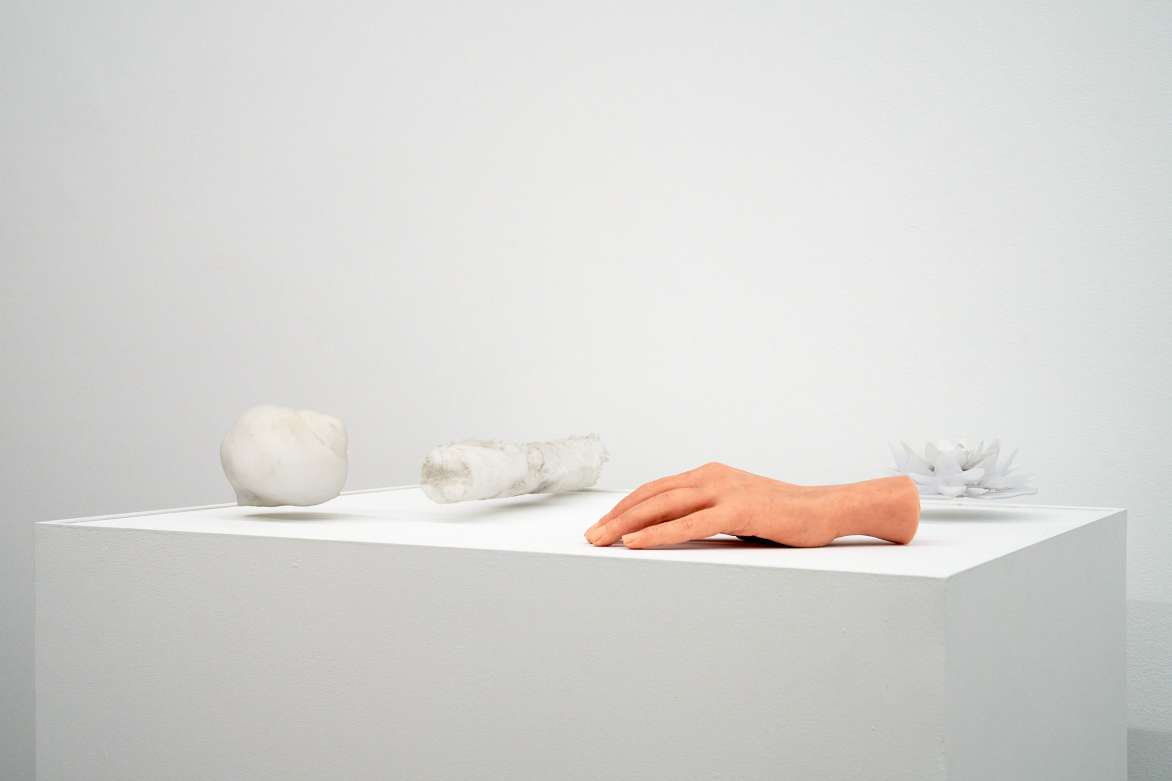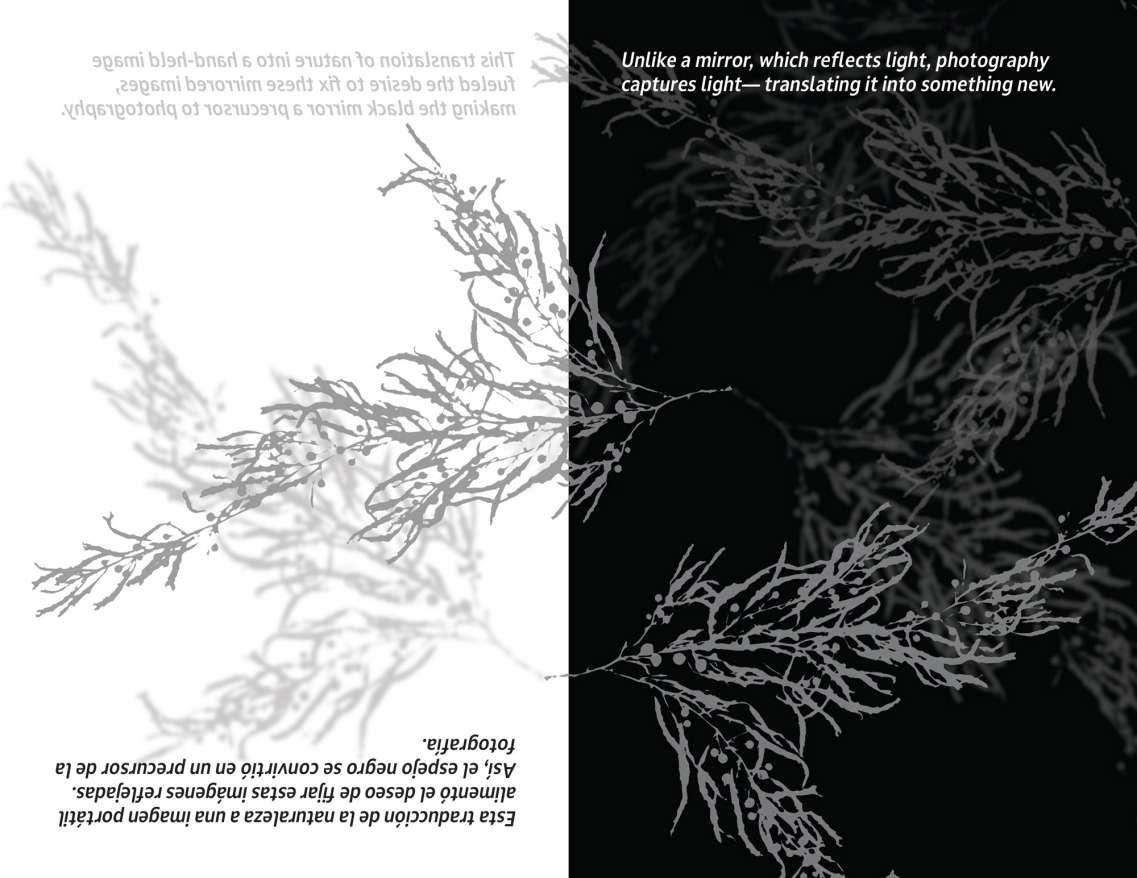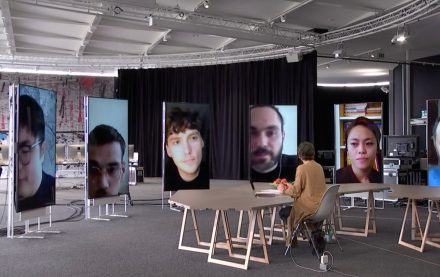The ACT Studio Course, co-taught by Judith Barry and Nida Sinnokrot, opens the possibility of examining what can be meant by the terms art, culture, and technology by considering what an art-culture-technology nexus can generate—imaginatively, historically, and in relation to the present—via examining forms, production, placement, and diffusion/distribution, in an effort to analyze these interrelationships and to experiment with what can be generated. Throughout the course, students probed the contemporary conditions of artists and cultural practitioners who position themselves as thinkers and as ethical beings.
ACT Studio is a meeting place allowing the sharing and presentation of ideas and projects that are being developed. This engaged study includes a variety of readings; exploring questions of theory and criticism; and examining works and practices. Students considered methods of investigation, display, and documentation, as well as explored modes and challenges of communication across disciplines. Students developed projects in which they organized research methods and goals, engaged in production, cultivated a context for their practice, and explored how to compellingly communicate, display, and document their work. Regular presentation and peer-critique sessions, as well as reviews involving ACT faculty and fellows and external guest reviewers, provided students with ample feedback as their projects developed.
ACT Class of 2020
Ryan Aasen
Luíza Bastos Lages
Rae Yuping Hsu
Matt Ledwidge
Casey Tang
Nancy Valladares
Ryan Aasen (SMACT ’20)
Ryan’s work is based on the legal and political history of privacy in the United States, and its relation-ship to various American institutions including Harvard Law School and the Department of Homeland Security. He is interested in exploring the contemporary, material presence of surveillance in daily life, and its manifestations in seemingly mundane objects. Using images, sculpture, and performance, Ryan wants to reposition the (nearly) invisible politics of these objects away from division, control, order, and fear, and open them up as tools for a potentially transgressive autonomy.
Luiza Bastos Lages (SMACT ’20)
Ordem em Progresso [Order in Progress] was conceived as a sensitive response to the current growth of authoritarian political re-gimes. This work was specifically motivated by the recent election of extreme right-wing Brazilian politician Jair Bolsonaro, and aims to resonate with other contexts in which there is growing naturalization of violence against existences that challenge predefined social expectations. The work is comprised of two pieces. Expressed through videos and installations, each of them relates to a specific stage of the electoral process as well as the start of the new government in Brazil. Anotações em Exílio [Notes in Exile] (2018) is composed of two videos: Antecipação [Anticipation] and Confirmação [Confirmation]. Antecipação [Anticipation] relates to the tension of the pre-election period, which Luiza experienced vicariously from afar by way of innumerable testimonies and messages from family and friends. They shared the rise of threats and violence against marginalized identities; especially of lesbians, facing debate of the unnegotiable, discussion of their very right to existence. The second video, Confirmação [Confirmation], refers to the desolation of un-certainty through a confirmation. It demonstrates uncertainty about an attempted erasure; uncertainty if any resistance against this obliteration might be possible. Medida provisória Nº 870 de 01 de Janeiro de 2019 [Provisional Measure No. 870 of January 1, 2019] (2019) was set in motion by one of the first set of legislative changes made by the new government. Although the results of these decisions will unfold as time goes on, they portray how state power both suppresses and shreds – suppresses and shreds those whose existence, while dominated, is instrumental to the propagation of an oligarchic society – despite its democratic face. The legislative changes attest to the possibility that authoritarian regimes constitute an expansion of neoliberalism’s exploitation and domestication of bodies: human and nonhuman.
Rae Yuping Hsu (SMACT ’20)
“My cells hold memory of this earth, they remain at the same salinity of the waters I emerged from 500 million years ago. My cells house bits of other creatures, slowly burning at 50 degree Celsius. My cells harbor a myriad of nutrients, from rock to soil to water to plants. I am soil, water, plant, and rock. There is no entity I cannot know that isn’t related by air, hydrated by water, grounded by gravity. And yet I remain so alienated, and they remain inconceivably other. I push to recognize the microbeness of a microbe and the microbeness of a human as well as the humanness of a microbe in hopes of revising the humanness of the human. I resist this logic that severs their pain from mine, this logic that renders violence less visible, and in doing so, I let myself become vulnerable and open, practicing a primordial participation of taking up and being taken up.”
Matt Ledwidge (SMACT ’20)
Matt’s work, The Crisis of Distinction, consists of several mounted texts and digital still images distributed through the space generated through photogrammetric modeling. The still images are placed so as to produce a sequence of ambulatory visual interpolation of a film which does not exist, where each image and text are optically located in relation so as to produce a narrative sequence. The work centers around a modeled reproduction of a site located in Ein Qiniya, Palestine. The images are produced through the process of photogrammetry which allows for the measurement and computational modeling of physical objects. Hundreds of images were interpolated to produce a visualized estimate of the spatial locations of the visual plane of each aligned image, and of overlapping features of the captured space.
The work probes the ambivalent desires and critique of the aesthetic relations of chance, capture, and memory inherent to these images, and by extension is concerned with, and implicated within histories of orientalism and the politics of technical systems of environmental modeling. Drawing parallels to the orientalist photographic travels to Palestine in the early history of photography, the work borrows language regarding the desires, spatial conditions and ontological implications of a new technology in its relation to the landscape. Drawing from several sources, an ambiguous relationship to the operational images as archaeological, forensic, touristic, militaristic, conservationist, filmic, surveillant or a video game is produced. The work seeks to focus on the different often contradictory, environmentalities and erasures evoked by environmental models through their modulation of conditions of attention, legibility, memory, and agency. In the process of exclusion and inclusion of information, the captured visual information floods towards to thresholds of marginal spaces of emptiness. These gaps of accidental malfunction, leakages of image, and lack of human figures – direct scrutiny towards the interpolated production of the photographic character as a conduit of external stimuli, and as index of a subjective encounter in the documentary process. The ambulatory gaze of the virtual film disrupts any coherent totalizing perspective on the visible environment, an indirect looking generates a fragmentation and a searching which modulates between more embodied and disembodied models of interpretation. This is informed by the modernist filmic, exhibitionary, and pedagogical interface which produces its subject as pattern sensing, as an organizer and sensitive conduit for whom the crisis of distinction between control and randomness becomes an aesthetic and generative encounter, placing them in lineage with the anxieties, postures and social processes of attention of nineteenth century orientalism. In turn the desires and anxieties surrounding that which is legible or detectible, that which is registered yet unseen in the production of landscape as an object of software, point toward the inherent limits of the technology and a refusal to be processed.
The spatial arrangement of images implicates a viewer in processes of interpolation, with the choreography of viewsheds producing images and texts as mutually visible enjambments which generate an authorial abnegation and an invitation to identification with the processes of attention, slow violences, and the epistemic politics of technologies of environmental visualization.
Casey C Tang (SMACT ’20)
Casey is currently interested in forms of systems and relationality. His piece consists of three texts, each one sung by a different performer. The performers move around the space com-ing together then dispersing. They hum to the resonance of the room moving in and out of one note harmony. The text and singing overlap and intertwine in and out of each other. The syntax of the texts are based on a form of Chinese poetry which contains no personal pronouns or prepositions. With the absence of these markers, the emphasis is placed on the verb, place, and time. Performed and Improvised by:Giulia Accornero, Adrian Cho, and Katherine Lazar
Nancy Dayanne Valladares (SMACT ’20)
Studying patterns of migration and movement through the lens of extractive economies, botany, and soil, Botanical Ghosts engages with the colonial legacies and agricultural histories of Honduras. The voyage of the Ackee tree or Blighia Sapida has a complex story of migration, which entwines with the geographical and economic landscape of slavery and colonization of the Caribbean.
She was struck by the smiling pear-shaped fruit during a trip to Lancetilla Botanical Garden in Tela, Honduras, where Dorothy Popenoe, a British archaeologist and botanist, died after consuming an unripe Ackee. It traversed the middle passage on a slave ship bound for Jamaica, made its way to England in the hands of captain William Bligh, and ended up in the experimental station in Honduras set up by Dorothy’s husband Wilson Popenoe in the service of United Fruit Company.

